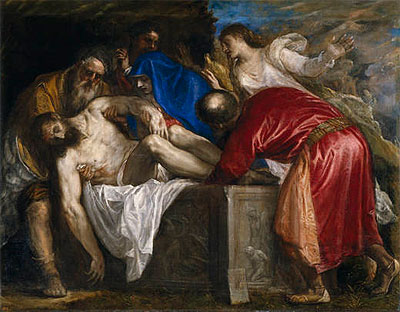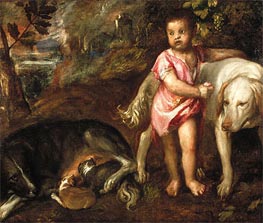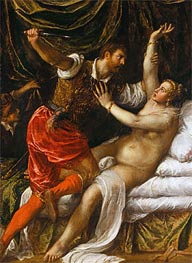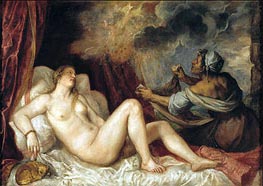Die Grablegung Christi, 1559 Tiziano Vecellio Tizian (c.1485-1576)
Standort: Prado Museum Madrid SpainOriginalmaß: 136 x 174.5 cm


Die Meisterwerke von Titian neu erschaffen: Video zu TOPofARTs Reproduktionen in Museumsqualität
Das Video zeigt den Prozess der Handmalerei eines Meisterwerks von Titian mit äußerster Präzision und Liebe zum Detail.
Ölgemälde Reproduktion
Wenn Sie eine andere Größe als die angebotene wünschen
Beschreibung
Gemalt von europäischen Künstlern mit akademischer Ausbildung
Museumsqualität
+ 4 cm Spielraum zum Dehnen
Erstellungszeit: 8-9 Wochen
Erstellungsprozess
Wir schaffen unsere Gemälde in Museumsqualität und unter Berücksichtigung höchster akademischer Standards. Die Gemälde-Reproduktion wird vollständig mit Ölfarben auf eine leere Leinwand gemalt. Wir fügen zusätzlich 4 cm leeren Abstand über die angebotene Gröβe hinzu, welche für strecken der Leinwand auf den Keilrahmen benutzt werden.
Die Schaffung Ihrer Tiziano Vecellio Tizian nimmt Zeit in Anspruch. Das Bild sollte nicht zu schnell gemalt werden, man sollte keinen Fristen hinterherjagen. Das Bild benötigt Zeit, um hohe Qualität und Detailtreue zu erreichen, sowie um vollständig versandbereit zu trocknen. Abhängig vom Aufwand, von der Detailgetreue und Bildgröße, brauchen wir 8-9 Wochen, um das Bild fertig zu stellen.
Wenn eine Änderung in Bezug auf die Frist notwendig sein sollte, oder sollte Ihre Bestellung in einer für uns äuβerst belebten Periode aufgegeben werden, werden wir Sie per E-Mail über die, von uns für Ihre Reproduktion gebrauchte Zeit, informiert.
Wir rahmen unsere Ölgemälde-Reproduktionen nicht ein. Die Ölgemälde sind ein kostenaufwendiges Produkt, und die Gefahr einer Beschädigung eines im Rahmen gespannten Gemäldes während des Transportes ist äuβerst hoch.
Außerdem gibt es postalische Beschränkungen bezüglich der Größe der Sendung.
Darüber hinaus kann der Versandpreis aufgrund der Abmessungen der gespannten Leinwand den Preis des Produkts selbst übersteigen.
Sie können Ihr Gemälde in Ihrem örtlichen Rahmengeschäft aufspannen und einrahmen.
Versand
Sobald das Gemälde Die Grablegung Christi fertig und trocken ist, wird es an Ihre Lieferadresse versendet.
Wir bieten kostenlosen Versand sowie kostenpflichtige Express-Transportdienste an.
Die Leinwand es eingerollt, in einem festen und sicheren Versandrohr. Sie können den Versandpreis mit dem Tool Geschätzte Steuern und Versandgebühren überprüfen.
Museumsqualität
TOPofART Gemälden stellen wir nur mit Museumsqualität her. Unsere Künstler mit akademischer Ausbildung lassen keine Kompromisse in Bezug auf die Qualität und der Detailtreue des bestellten Gemäldes zu. Wir pflegen keine Zusammenarbeit und werden nie eine solche mit Ateliers mit niedriger Qualität aus dem Fernen Osten zulassen. Wir sind in Europa ansässig, und Qualität ist unsere leitende Priorität.
1 Reviews
5.00 Gesamtbewertung
The canvas was commissioned by Philip II in 1559 and was sent to him in the same year. It has capital importance in the development of Titian's style. The portrayal of the tragedy, which the painter had masterfully achieved in epic form in a youthful work now in the Louvre, is here shown in terms of a living, suffering participation to which the pictorial language is extraordinarily appropriate.
It is significant that the bearded Joseph of Arimathea, who supports the body of Christ, is more than probably a self-portrait. Knowingly composed, the figures are distributed in a fan-like scheme and are racked by spasms of grief. But it is the colour that controls all the elements, starting from the livid body of Christ and from the white shroud falling over the side of the tomb, which is decorated with bas-reliefs. The last are the only unessential, ornamental notes in this tragic group. The bloodless body of Christ and the weight of His listless arm are unforgettable.
Unforgettable, too, is the figure of the Magdalen. Most extraordinary, however, is how colour creates the individual figures, so that the space is reduced, attenuated and leaves us breathless. Dvorak rightly suggested that in this moment Titian, 'renouncing the intoxication of the senses of his youthful works, had sought to find himself in a higher and more remote region of the spirit.'
There is much to say about Titian's sense of religion, which is not to be confused with any didactic or pietistic zeal of the type that activated Counter-Reformation policy in the arts and was urged on him by some patrons - as exemplified in a canvas in the Prado titled Spain Succouring Religion which in fact consists of two feminine beauties counterpoised, one richly dressed, the other nude. Yet a dramatic concept of humanity in terms of its myths and its history, and of the nature that seems to echo it, is more and more apparent in the works of the last period, from the late Entombment and St. Lawrence, also in the Prado, to the St. Sebastian in St. Petersburg and Apollo and Marsyas in Kormeriz, Czech Republic.




